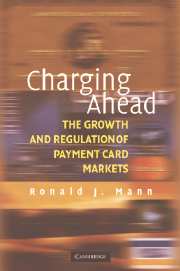Book contents
- Frontmatter
- Contents
- Figures and Tables
- Acknowledgments
- Introduction
- PART I THE BASICS OF PAYMENT CARDS
- PART II EASY MONEY
- PART III THE PUZZLE OF PAYMENT CARDS
- PART IV REFORMING PAYMENT SYSTEMS
- PART V OPTIMIZING CONSUMER CREDIT MARKETS AND BANKRUPTCY POLICY
- Conclusion
- Appendix: Country-Level Data
- Notes
- Bibliography
- Index
PART IV - REFORMING PAYMENT SYSTEMS
Published online by Cambridge University Press: 06 July 2010
- Frontmatter
- Contents
- Figures and Tables
- Acknowledgments
- Introduction
- PART I THE BASICS OF PAYMENT CARDS
- PART II EASY MONEY
- PART III THE PUZZLE OF PAYMENT CARDS
- PART IV REFORMING PAYMENT SYSTEMS
- PART V OPTIMIZING CONSUMER CREDIT MARKETS AND BANKRUPTCY POLICY
- Conclusion
- Appendix: Country-Level Data
- Notes
- Bibliography
- Index
Summary
The problems plainly differ from country to country, and the U.S. pattern is not likely to become the global norm. Still, policymakers around the world struggle with the effects of credit card use and debt. The data discussed in Part II suggest that their concern is well founded.
How should governments respond to the problems with credit cards without undermining the efficiency of retail payment systems? A useful framework is to distinguish two categories of risks or consumer errors as jointly contributing to the problem of excessive card usage. The first relates to the efficiency of the credit card as a lending device. I call this the convenience risk and discuss it in Part V. The concern is that it is so easy to use a credit card (i.e., the transaction costs of credit card lending are so low) that borrowers underestimate the risks associated with future revenue streams. The response is to intervene in the market for consumer lending. The second, the topic of Part IV, I call the instrument-induced risk. This risk is attributable specifically to the use of a credit card as a payment device. Because credit cards encourage consumers to spend more than they otherwise would, and perhaps more than they can repay out of monthly incomes, credit card use can lead to unanticipated debt.
- Type
- Chapter
- Information
- Charging AheadThe Growth and Regulation of Payment Card Markets around the World, pp. 119 - 120Publisher: Cambridge University PressPrint publication year: 2006

